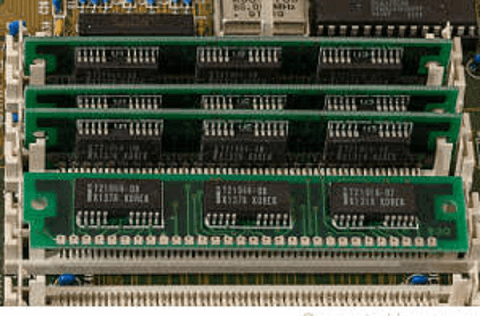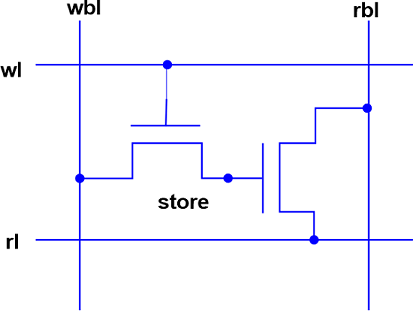What is Asynchronous DRAM?
Asynchronous DRAM (Dynamic Random Access Memory) is a type of memory that operates independently of the system clock. It is not synced with the computer system clock; therefore, it is known as being "asynchronous". SDRAM (synchronized DRAM), which responds to read and write operations in synchrony with the signal of the system clock, is a common memory technology in modern PCs.
Unlike synchronous DRAM, which is synchronized with the system clock, asynchronous DRAM can be accessed at any time, regardless of the clock's state. This allows for faster data access and improved system performance, as the clock speed does not limit the memory. This can be beneficial when the system needs to access data quickly, such as in high-performance computing or real-time applications.

Uses of Asynchronous DRAM
Asynchronous DRAM has many uses due to its ability to operate independently of the system clock and low power consumption. Some of the most common uses of asynchronous DRAM include:
High-Performance Computing: Asynchronous DRAM is often used in high-performance computing systems, such as supercomputers, due to its ability to access data and improve system performance quickly.
Embedded Systems: Asynchronous DRAM is commonly used in embedded systems, such as industrial control systems, automotive systems, and consumer electronics, due to its low power consumption and flexibility in terms of timing.
Mobile Devices: Asynchronous DRAM is also used in mobile devices, such as smartphones and tablets, due to its low power consumption and ability to access data quickly.
Networking Equipment: Asynchronous DRAM is also used in networking equipment, such as routers and switches, due to its ability to access data and improve system performance quickly.
Gaming Consoles and PCs: Asynchronous DRAM is also used in gaming consoles and personal computers for the same reasons as mentioned above, improving the performance and responsiveness of the system.
Automotive Applications: Asynchronous DRAM is also used in automotive applications such as infotainment systems, advanced driver-assistance systems, and autonomous driving systems.
Overall, Asynchronous DRAM is a versatile type of memory that can be used in many applications, including high-performance computing, embedded systems, mobile devices, networking equipment, gaming consoles and PCs, and automotive applications.
Advantages of Asynchronous DRAM
- Faster data access: Asynchronous DRAM can be accessed at any time, allowing for faster data access and improved system performance.
- Flexibility in terms of timing: Asynchronous DRAM is not dependent on the system clock, making it more versatile and able to be used in a wide range of applications.
- Low power consumption: Asynchronous DRAM can operate at a lower frequency than synchronous DRAM, which helps to reduce power consumption and heat dissipation.
- Reduced latency: Asynchronous DRAM can quickly retrieve data, reducing the amount of time it takes for the system to access the necessary information.
- Variety of available types: Asynchronous SRAM, Asynchronous DRAM, and Asynchronous DRAM with burst mode are different types of asynchronous DRAM with specific uses and advantages.
- Cost-effective: Asynchronous DRAM is generally less expensive than synchronous DRAM, making it a cost-effective solution for many applications.
- High-performance: Asynchronous DRAM is often used in high-performance computing systems, such as supercomputers, gaming consoles, and personal computers, for improved performance.
- Low-power consumption: Asynchronous DRAM is commonly used in embedded systems, mobile devices, and other low-power systems for low power consumption.
Disadvantages of Asynchronous DRAM
- Less predictable performance: Because Asynchronous DRAM is independent of the system clock, its performance may be less predictable as compared to synchronous DRAM.
- Limited memory capacity: Asynchronous DRAM typically has a lower memory capacity than synchronous DRAM, which can be a disadvantage in some applications.
- Limited clock frequency: Asynchronous DRAM is limited in the frequency it can operate, it may not be suitable for high-speed or high-bandwidth applications.
- Potential for data loss: Asynchronous DRAM is not always buffered and may be subject to data loss in the event of a power outage or other failure.
- Not suitable for all systems: Asynchronous DRAM may not be the best choice for all systems, as it may only be compatible with some types of processors or other components.
- Reduced memory bandwidth: Asynchronous DRAM may also have a lower memory bandwidth compared to synchronous DRAM.
- Limited burst mode: Asynchronous DRAM with burst mode may only be suitable for some types of applications, as it may not be able to read or write a block of data as fast as other types of memory.

Some Important Points about Asynchronous DRAM
- Asynchronous DRAM (ADRAM) is a type of dynamic random-access memory that operates independently of the system clock.
- ADRAM does not require a clock signal to synchronize its operations with the rest of the system. Instead, it relies on a separate control signal to initiate memory access.
- ADRAM can be used in systems with a wide range of clock speeds, making it ideal for use in embedded systems and other applications where power consumption and system complexity are major concerns.
- ADRAM typically requires fewer pins than synchronous DRAM (SDRAM), which can help reduce a system's cost and complexity.
- ADRAM is slower than SDRAM and may be more difficult to find and expensive.
- When considering ADRAM, it's important to evaluate the trade-offs between its benefits and limitations and weigh them against the application's specific requirements.
- Asynchronous SRAM (ASRAM) is another name for ADRAM; it is a type of static RAM (SRAM) that does not require a clock signal.
- ADRAM can be useful in systems where power consumption is a critical concern, as it does not require a clock signal which can consume a significant amount of power.
- ADRAM can be used with other memory technologies and interfaces to create a hybrid and fully asynchronous system that reduces power consumption and increases system reliability.
Summary
Asynchronous DRAM (ADRAM) is a type of memory that operates independently of the system clock. Unlike synchronous DRAM, ADRAM does not require a clock signal to synchronize its operations with the rest of the system. Instead, it relies on a separate control signal to initiate memory access.
However, ADRAM has some limitations compared to SDRAM. For example, it is typically slower than SDRAM and may require more complex control logic. Additionally, ADRAM is less common than SDRAM and may be more difficult to find and expensive.
Asynchronous SRAM (ASRAM) is another name for ADRAM; it is a type of static RAM (SRAM) that does not require a clock signal. It is used in embedded systems and other applications where power consumption and system complexity are major concerns.
When considering ADRAM, it's important to evaluate the trade-offs between its benefits and limitations and weigh them against the application's specific requirements. In some cases, it may be appropriate to use ADRAM in conjunction with other memory technologies and interfaces to create a hybrid and fully asynchronous system that reduces power consumption and increases system reliability.